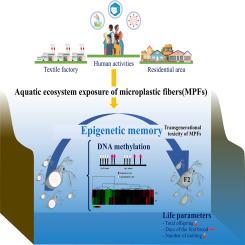微塑料纤维诱导的跨代表观遗传破坏损害了大水蚤的适应性
IF 4.3
2区 环境科学与生态学
Q1 MARINE & FRESHWATER BIOLOGY
引用次数: 0
摘要
微塑料纤维(mpf)是淡水环境中最普遍的微塑料类型。然而,尽管塑料污染对各种水生物种的影响已经得到了广泛的研究,但MPFs对水生生物代际影响的潜在机制仍然知之甚少。在这里,我们研究了MPFs在大水蚤中超过三代的多代和跨代毒性。我们的研究结果表明,MPFs暴露会对后代的繁殖和换羽频率产生负面影响。值得注意的是,尽管从未直接暴露于mpf,但跨代组在F1和F2代(F1T和F2T)表现出生殖障碍和换毛频率降低。此外,亚硫酸氢盐全基因组测序显示,这些跨代不利影响与特定基因的差异DNA甲基化模式有关,表明MPFs可能通过表观遗传修饰威胁水蚤种群。总的来说,我们的发现为MPFs的代际毒性和驱动这些反应的潜在分子机制提供了有价值的见解。本文章由计算机程序翻译,如有差异,请以英文原文为准。

Microplastic fiber-induced transgenerational epigenetic disruption impairs fitness in Daphnia magna
Microplastic fibers (MPFs) are the most prevalent type of microplastics in freshwater environments. However, although the effects of plastic pollution on various aquatic species have been extensively studied, the underlying mechanisms of the intergenerational effects of MPFs on aquatic organisms remain poorly understood. Here, we investigated the multi- and transgenerational toxicity of MPFs in Daphnia magna over three generations. Our findings revealed that MPFs exposure negatively affects reproduction and molting frequency across generations. Notably, the transgenerational groups exhibited reproductive impairments and reduced molting frequency in the F1 and F2 generations (F1T and F2T), despite never being directly exposed to MPFs. Furthermore, whole-genome bisulfite sequencing revealed that these transgenerational adverse effects are associated with differential DNA methylation patterns in specific genes, suggesting that MPFs may threaten Daphnia populations through epigenetic modifications. Collectively, our findings provide valuable insights into the intergenerational toxicity of MPFs and the underlying molecular mechanisms driving these responses.
求助全文
通过发布文献求助,成功后即可免费获取论文全文。
去求助
来源期刊

Aquatic Toxicology
环境科学-毒理学
CiteScore
7.10
自引率
4.40%
发文量
250
审稿时长
56 days
期刊介绍:
Aquatic Toxicology publishes significant contributions that increase the understanding of the impact of harmful substances (including natural and synthetic chemicals) on aquatic organisms and ecosystems.
Aquatic Toxicology considers both laboratory and field studies with a focus on marine/ freshwater environments. We strive to attract high quality original scientific papers, critical reviews and expert opinion papers in the following areas: Effects of harmful substances on molecular, cellular, sub-organismal, organismal, population, community, and ecosystem level; Toxic Mechanisms; Genetic disturbances, transgenerational effects, behavioral and adaptive responses; Impacts of harmful substances on structure, function of and services provided by aquatic ecosystems; Mixture toxicity assessment; Statistical approaches to predict exposure to and hazards of contaminants
The journal also considers manuscripts in other areas, such as the development of innovative concepts, approaches, and methodologies, which promote the wider application of toxicological datasets to the protection of aquatic environments and inform ecological risk assessments and decision making by relevant authorities.
 求助内容:
求助内容: 应助结果提醒方式:
应助结果提醒方式:


